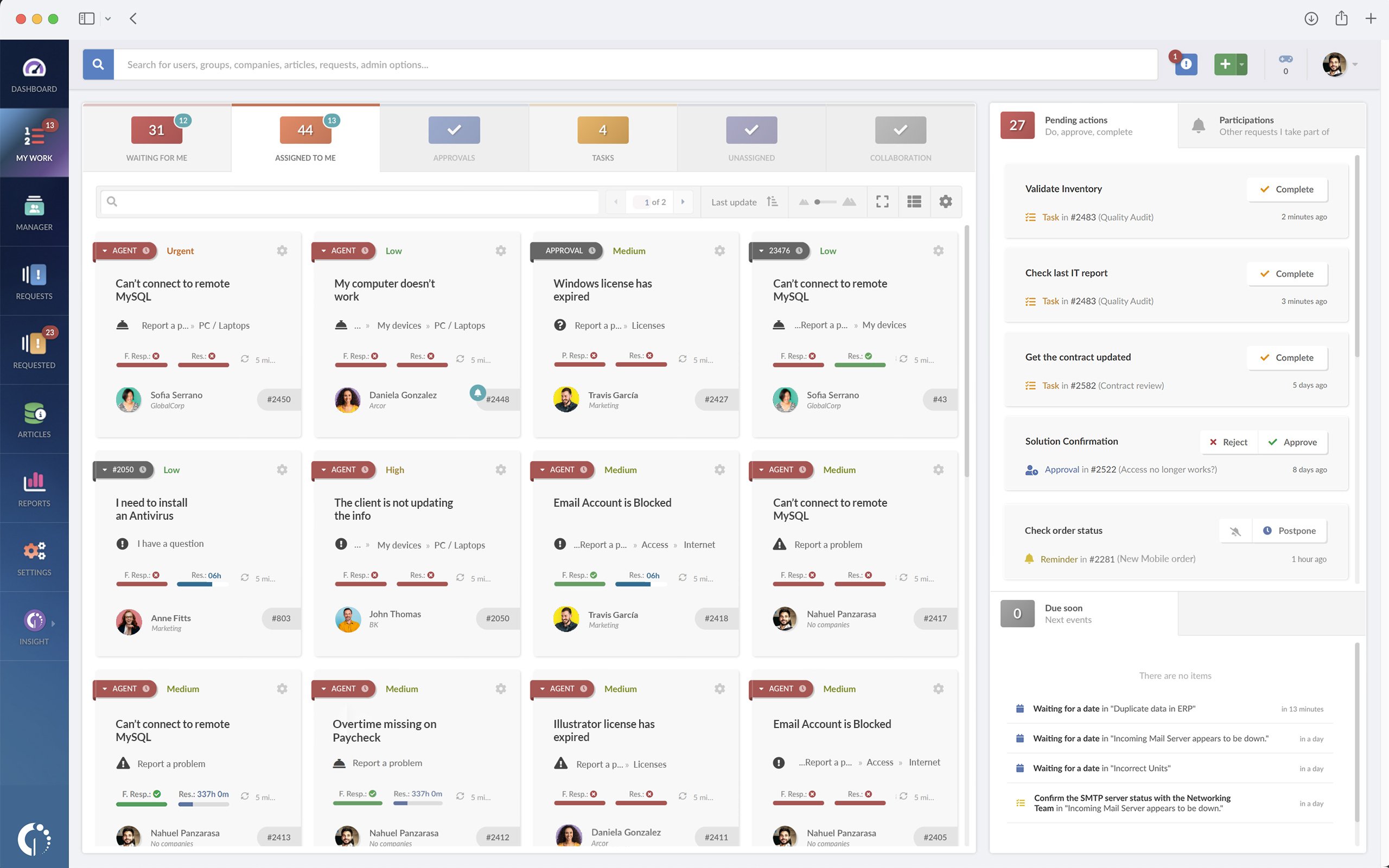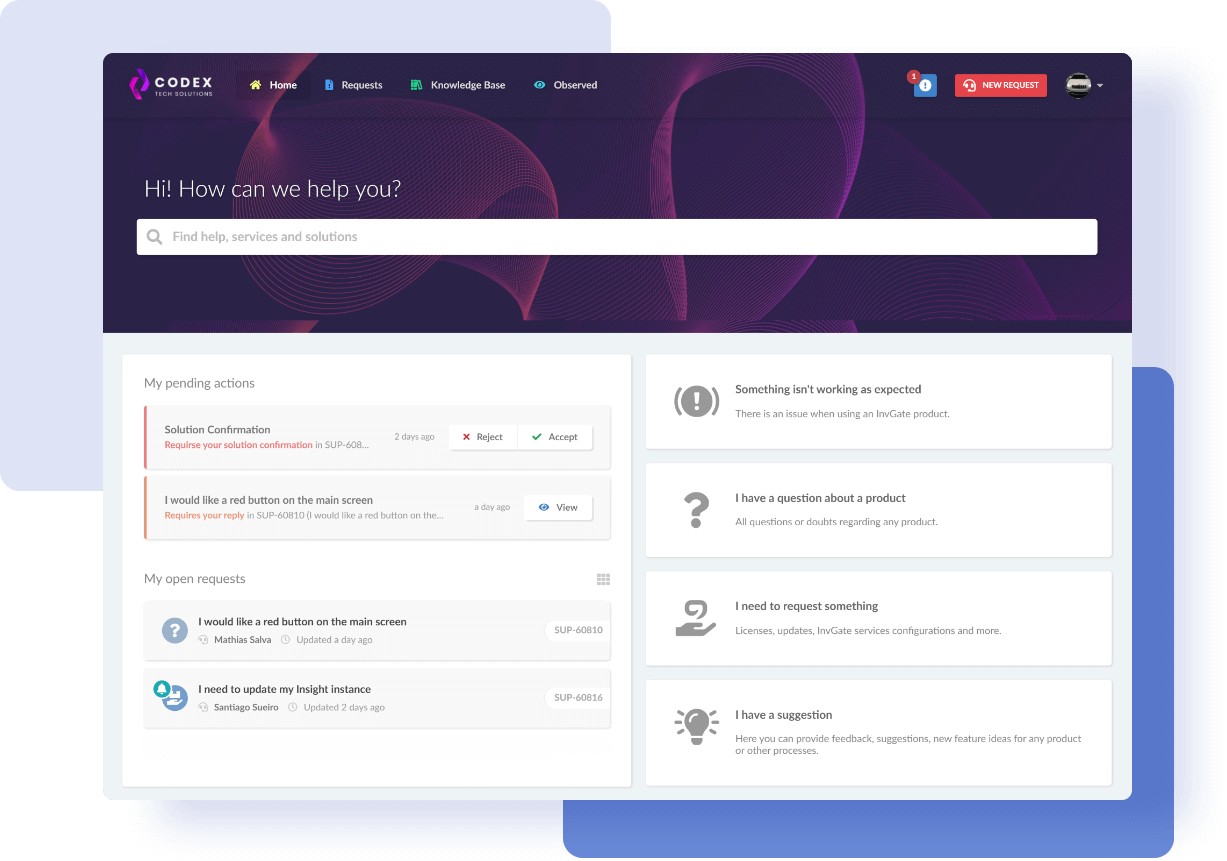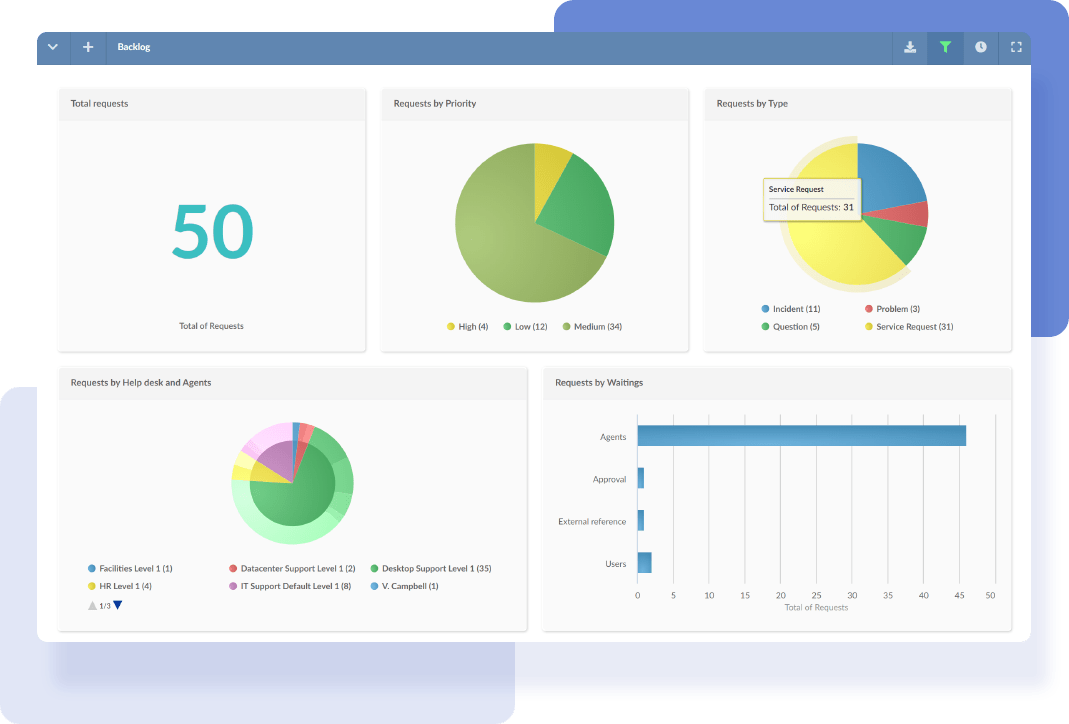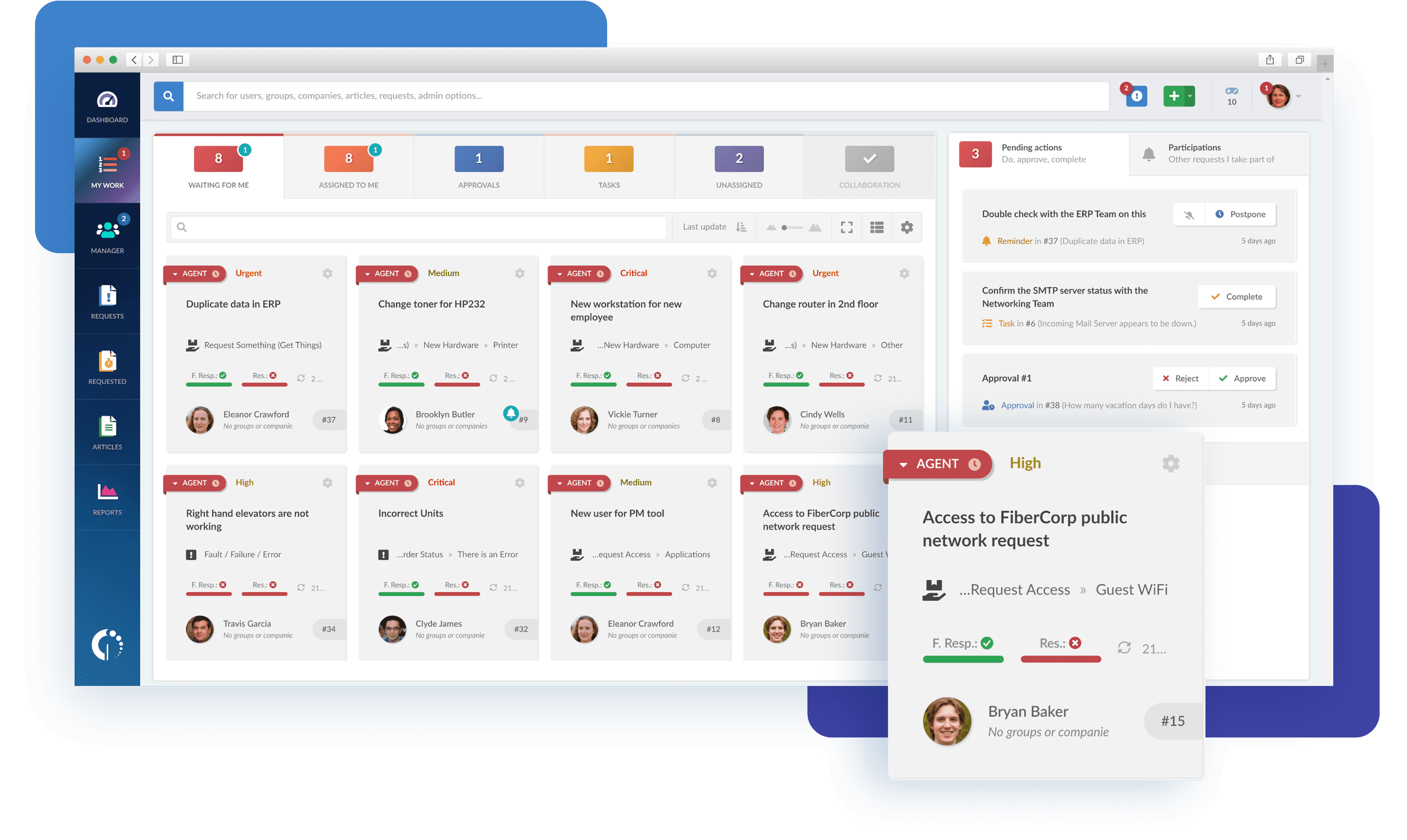Are you comparing SymphonyAI Summit Service Management vs. Jira Service Management in your search for an IT Service Management (ITSM) solution?
In this blog post, we’ll dive into an ITSM tools comparison, scrutinizing these two formidable contenders in service desk software platforms.
However, the ITSM world is vast and diverse, and sometimes, the perfect solution may not be immediately apparent. That's why we've got an alternative up our sleeves: InvGate Service Management. This solution may just be the missing piece that seamlessly fits your organization's ITSM puzzle.
Keep reading to compare these ITSM giants to help you unearth the ideal solution for your organization's unique needs.
Table of contents
- TL;DR
- What is SymphonyAI Summit Service Management?
- What is Jira Service Management?
- Considering InvGate Service Management as an ITSM solution alternative
TL;DR
- SymphonyAI Summit Service Management impresses with flexibility, rich ITIL-aligned features, user-centric design, and cost efficiency, yet faces concerns over platform performance, configuration limitations, and customer support.
- Jira Service Management stands out for its customizable workflows, and integration capabilities but encounters challenges like migration complexities and limited native integrations.
- InvGate Service Management, in contrast, excels in robust ticketing, user adaptability, and ITSM solutions, emphasizing cost-effectiveness and IT Asset Management capabilities, among others.
We tried to be as thorough as possible, but if you don't have enough time to read it through and through, here's (another) TL;DR: InvGate Service Management can do everything we say here, and you can test it right away for free for 30 days.
Most looked-at features by buyers
When evaluating ITSM solutions, potential buyers tend to focus on specific functionalities that align with their organization's needs. These sought-after features are critical to making an informed decision.
Let's take a closer look at the fundamental aspects that prospective buyers typically prioritize when comparing ITSM tools.
- Support automation and Workflow Management - Buyers actively seek software solutions that offer automation capabilities to streamline everyday tasks like ticket routing, approvals, and escalations. These automation features lead to increased efficiency and productivity.
- Efficient Asset Management - Users prioritize software that offers robust IT Asset Management capabilities to help them maintain accurate inventories and optimize resource utilization within their organizations.
- Ticket Management System - Buyers attach significant importance to having a comprehensive Ticket Management System integrated into their help desk software. This feature facilitates the effective tracking, assignment, and resolution of customer inquiries and support requests.
- User-friendly experience and interface - Buyers take into account the platform's user interface and experience, focusing on its ease of use and how it contributes to user adoption and productivity. They appreciate an intuitive interface that enables efficient interaction with the software. Additionally, for organizations with remote or mobile workforces, mobile accessibility is a crucial factor to consider.
- Scalability - Organizations experiencing growth and evolution need highly value solutions that can readily adapt to their expansion and allow for customization. It is imperative for the solution to provide the ability to create custom fields, workflows, and extensions/plugins, enabling organizations to tailor the solution to match their unique business requirements.
- Seamless integration capabilities - Integration with other systems and applications is a critical requirement for buyers, as it ensures smooth data flow and process automation. The ability to integrate with existing tools and platforms is highly valued for improved efficiency and a unified user experience.
- Self-service portal and knowledge base - Buyers place great importance on the inclusion of a self-service portal, as it empowers end-users to independently resolve common issues and access relevant information without requiring direct assistance.
- Customization and flexibility - Buyers appreciate software solutions that provide customization options, allowing them to personalize the platform to suit their business needs. This flexibility ensures the software aligns with their unique workflows and processes, thereby enhancing user satisfaction and overall effectiveness.
- Streamlined IT service catalog - Organizations often require a service catalog that enables users to request specific IT services or resources. This feature simplifies service requests, offers visibility into available services, and facilitates effective service delivery management.
- Comprehensive reporting - Buyers seek help desk software with robust reporting tools, such as dashboards and reports, which offer valuable insights into their IT operations and performance. This data-driven approach facilitates informed decision-making and continuous service improvement.
- Pricing and support - Buyers assess the solution's cost-effectiveness, including licensing models, subscription plans, and any additional costs associated with features or users. The availability of customer support, documentation, and training resources also significantly influences their decision-making process.
- ITIL compliance - Many organizations adhere to ITIL best practices for IT Service Management. Buyers may favor solutions that support ITIL processes like Incident Management, Problem Management, Change Management, and Asset Management, as these processes align with their organizational standards.
What is SymphonyAI Summit Service Management?
SymphonyAI Summit, founded in 2015 and headquartered in Pune, India, provides AI-powered solutions for managing IT operations. Its flagship product, SymphonyAI Summit, is an IT Service Management solution that aligns with ITIL standards and incorporates cutting-edge AI-driven digital agents and automated services.
Furthermore, the company extends its offerings to include an IT Asset Management (ITAM) solution, which assists in Lifecycle Management, controlling expenses, and avoiding unnecessary purchases.
What users like from SymphonyAI Summit Service Management
Reputable sources like Gartner have received positive customer feedback about SymphonyAI Summit Service Management. Now, let's examine some of the benefits emphasized in these reviews.
- Flexibility and adaptability - SymphonyAI Summit Service Management empowers users to effortlessly manage workflows and support, facilitating dynamic adjustments to evolving needs. Users also appreciate the platform's simplicity when configuring conditions, validations, and changes.
- Features and capabilities - Users highly appreciate the platform for its rich array of features. This includes adherence to ITIL standards, out-of-the-box reporting prowess, seamless ticket relationship management, efficient automation via orchestration, and integrated AI capabilities.
- User experience - SymphonyAI Summit Service Management consistently earns accolades from users for its user-friendly dashboard layout, intuitive interface, and unwavering commitment to simplicity.
- Asset Management - The platform's IT Asset Management (ITAM) capabilities offer users a comprehensive and engaging experience. This encompasses features like mail-to-ticket and mail-to-service request (SR) functionality, bolstered by robust ITAM tools.
- Multichannel engagement - The platform excels in streamlining workflows and integrating processes. It seamlessly links Incident Requests (IR), Service Requests (SR), and Change Requests (CR) with assets and configuration items, enhancing the overall resource management experience.
- Training and support - The training team consistently receives accolades for their expertise and the effectiveness of their knowledge transfer. The platform's support services are praised for their promptness in addressing users' queries and challenges, providing immediate solutions.
- Cost-efficient solution - SymphonyAI Summit Service Management stands out as a cost-effective solution when compared to competitors. Users find significant value in the platform's pricing structure, which delivers robust features and capabilities without straining budgets.
What users don’t like from SymphonyAI Summit Service Management
While SymphonyAI Summit Service Management has numerous strengths and positive attributes, users have raised reservations about specific platform’s aspects. These insights have been derived from reviews conducted by reputable sources like Gartner. Let's delve into some of the issues that have been brought to the forefront.
- Performance and accessibility - Users have noted accessibility issues, with the platform being inaccessible for prolonged periods and experiencing significant slowdowns. Additionally, there have been suggestions for improving the application's response time.
- Configuration - Concerns have arisen regarding the platform's configuration, workflow, and administration capabilities, with some perceiving them as weak and in need of enhancement.
- Responsiveness - Another prevalent concern revolves around the platform's web interface performance. Users have reported issues related to speed and overall responsiveness. Additionally, there have been instances where attention appears to shift away from essential enhancements.
- Flexibility customization limitations - Although the platform offers customization options, certain restrictions have been reported, hindering users from achieving their desired levels of customization in specific areas.
- Reliability - Certain users have expressed the view that the platform's reliability needs improvement, suggesting that it would benefit from a more rigorous vetting process.
- Bugs - Reports of bugs causing conflicts between different teams' buckets have surfaced, impacting the overall reliability and stability of the system.
- Customer support - Some users have voiced dissatisfaction with the platform's customer support. Their concerns encompass delayed service when requesting reports, extended support timelines, and challenges related to bug fixing and product updates.
- Costs and licenses - Some users find the licensing costs relatively high, leading to comparisons with other tools available in the market.
- Additional suggestions - Users have highlighted a couple of specific points. Firstly, there is a desire for an alert or reminder option within the platform. Secondly, comments have surfaced regarding the need for improved platform documentation.
What’s SymphonyAI Summit Service Management’s argument over Jira Service Management?
When considering SymphonyAI Summit Service Management in comparison to Jira Service Management, several compelling arguments emerge in favor of SymphonyAI Summit.
- Flexibility and adaptability - SymphonyAI Summit Service Management empowers users to efficiently manage workflows and support, facilitating dynamic adjustments to evolving needs.
- Features and capabilities - Users value SymphonyAI Summit Service Management for its extensive toolset.
- User experience - SymphonyAI Summit Service Management consistently garners praise for its user-friendly interface, intuitive dashboard layout, and overall commitment to a simple and enjoyable user experience.
- Asset Management - SymphonyAI Summit Service Management's ITAM capabilities provide users with a comprehensive and engaging experience.
- Multichannel engagement - SymphonyAI Summit Service Management excels in streamlining workflows and integrating processes.
- Training and support - Users consistently commend SymphonyAI Summit Service Management's training team for their expertise and the effectiveness of knowledge transfer.
- Cost-efficiency - SymphonyAI Summit Service Management is recognized for its cost-effectiveness in comparison to competitors, delivering substantial value through its pricing structure.
What is Jira Service Management?

Jira Service Management, a product created by Atlassian, is a specialized platform geared towards IT Service Management. It offers organizations a highly efficient solution for streamlining their service desk operations. With its robust features and user-friendly interface, Jira Service Management empowers businesses to optimize their service delivery and enhance customer satisfaction. Currently, it provides the choice of a cloud-based service, allowing organizations to leverage the advantages of cloud computing for their Service Management needs.
Atlassian, the company responsible for Jira, was founded in 2002 by Mike Cannon-Brookes and Scott Farquhar in Sydney, Australia. Since its establishment, the company has experienced remarkable growth and expanded its global presence by establishing offices in various countries, including the United States, Netherlands, Japan, and the Philippines.
Atlassian specializes in creating software and tools specifically tailored for developers and project managers. Their extensive product portfolio includes well-regarded offerings such as Confluence, Bitbucket, and Trello, which have gained widespread recognition in the industry. These versatile tools cater to a variety of requirements, ranging from project management and issue tracking to collaborative content creation, code management, and team coordination.
What users like from Jira Service Management
Analysis of reviews in sources such as Gartner and G2 reflects the positive feedback expressed by Jira Service Management users. Here are some of the key benefits that have been recognized.
- Intuitive and user-friendly interface - Users highly commend the platform's user-friendly interface, which enhances Incident and Request Management. The design promotes ease of use, enabling teams to navigate and interact with the system effortlessly.
- Efficient ticketing system with customizable workflows - Jira Service Management's ticketing system, combined with customizable workflows, simplifies task management.
- Enhanced user portal for self-service and feedback - The platform features an improved user portal that elevates the self-service experience for users. Users also have the capability to rate the overall process upon issue resolution, providing valuable feedback that contributes to continuous improvement and customer satisfaction efforts.
- Comprehensive task details and robust filtering capabilities - This feature offers teams a holistic understanding of their work, providing in-depth information about each task. Additionally, the platform offers robust filtering capabilities, allowing users to search, sort, and organize tasks based on specific criteria.
- Simplified sprint planning and task assignment - Jira Service Management seamlessly integrates with popular collaboration platforms like Slack and Teams, streamlining the processes of sprint planning and task assignment. The Kanban view serves as a centralized hub for managing tasks, and the tagging function facilitates the efficient organization of project-specific tasks.
- Flexible pricing options - Jira Service Management offers a variety of flexible pricing options to cater to organizations of different sizes and budget constraints. This includes a free plan suitable for small teams of up to three users with 2 GB of storage. The cloud-hosted option provides a reasonably priced base package.
What users don’t like from Jira Service Management
While Jira Service Management has many strengths and positive attributes, it is not without its share of customer concerns and dislikes. Evaluations from sources such as Gartner and G2 have identified recurring user criticisms.
- Challenging migration process - Users have raised concerns about the complexity of transitioning to Jira Service Management's projects. Some users have encountered difficulties that may require a separate user subscription, making the migration process cumbersome.
- Limited and complex integrations - Users have expressed a desire for more readily available integrations and have had to create custom solutions to connect Jira Service Management with specific tools. Integrating the platform with external systems can be a time-consuming and challenging process.
- Steep learning curve - The platform's robust capabilities and extensive functionalities can lead to a challenging user learning curve. Some individuals may require additional guidance or training to navigate and utilize the system and its features effectively.
- Limitations in task tracking and reporting - Users have faced challenges when tracking multiple tasks, generating comprehensive reports, and creating customized dashboards within the platform. These limitations can hinder users' ability to monitor and analyze project progress and performance effectively.
- Reliance on additional plugins - Users have indicated the need to rely on additional plugins to access basic features within the system. Furthermore, ensuring compliance with data protection regulations such as GDPR (General Data Protection Regulation) has presented challenges for some users.
- Less intuitive interface - In comparison to alternative options, certain users find Jira Service Management's interface less intuitive, particularly when external customers interact with the platform.
- Issues with Atlassian support - Users have reported difficulties when seeking assistance from Atlassian support. They have faced challenges in obtaining the necessary support and guidance, which can impact their overall experience.
What’s Jira Service Management’s argument over SymphonyAI Summit Service Management?
Jira Service Management presents a compelling case when comparing its strengths to SymphonyAI Summit Service Management. Here are key points of distinction that highlight Jira Service Management's advantages.
- Intuitive and user-friendly interface - Jira Service Management's interface is highly regarded by users for its intuitiveness and user-friendliness. This design enhances Incident and Request Management, promoting ease of use.
- Efficient ticketing system with customizable workflows - Jira Service Management has an efficient ticketing system coupled with customizable workflows, simplifying task management for organizations. This streamlined approach allows teams to track and prioritize tasks according to their unique requirements.
- Enhanced user portal for self-service and feedback - Jira Service Management's improved user portal elevates the self-service experience for users. Furthermore, it empowers users to rate the overall process upon issue resolution, contributing to continuous improvement and customer satisfaction.
- Comprehensive task details and robust filtering capabilities - Jira Service Management provides users with comprehensive task details, offering in-depth information about each task. Additionally, it offers robust filtering capabilities for organizing and managing tasks efficiently.
- Simplified sprint planning and task assignment - Jira Service Management seamlessly integrates with popular collaboration platforms like Slack and Teams, streamlining sprint planning and task assignment processes.
- Flexible pricing options - Jira Service Management offers a range of flexible pricing options tailored to organizations of varying sizes and budget constraints.
Considering InvGate Service Management as an ITSM solution alternative

While SymphonyAI Summit Service Management and Jira Service Management are prominent rivals within the ITSM sector, it's crucial to explore alternative solutions that better align with your organization's specific requirements. In this context, InvGate Service Management emerges as a compelling choice that warrants thorough consideration. Let's delve into the advantageous attributes of InvGate Service Management that make it a valuable option for fulfilling your organization's ITSM needs.
Robust Ticketing and Incident Management

InvGate Service Management excels in providing robust functionalities for ticketing and incident management. It facilitates efficient tracking, collaboration, and resolution of tickets, empowering IT teams to manage and prioritize incidents effectively. With features such as automated ticket routing, customizable workflows, and SLA Management, InvGate Service Management significantly enhances the efficiency of incident resolution processes.
Powerful self-service capabilities

InvGate Service Management incorporates potent self-service features, including a user-friendly portal, an extensive IT service catalog, and a knowledge base. These capabilities empower end-users to independently resolve common issues, access a wide array of IT services, and utilize self-help resources, thereby reducing the workload on IT staff.
Purpose-built for ITSM, perfect for ESM
InvGate Service Management is specifically designed for ITSM while seamlessly extending its capabilities to Enterprise Service Management (ESM). It empowers operational departments to enhance their processes and fully embrace the advantages of digital transformation. With a primary focus on ITSM and strong performance in ESM, InvGate Service Management enables streamlined workflows and comprehensive digital transformation initiatives across all departments.
ITIL-certified readiness
InvGate Service Management has attained the prestigious ITIL4 certification from PINK Elephant, demonstrating its commitment to upholding ITSM excellence. Whether organizations are embarking on their ITIL journey or managing complex operations, InvGate Service Management provides a user-friendly and feature-rich experience aligned with industry best practices.
Comprehensive reporting and analytics

InvGate Service Management offers comprehensive reporting and analytics functionalities, enabling organizations to gain valuable insights into their IT operations and performance. The platform provides pre-built reports and customizable dashboards, empowering IT teams to analyze data, recognize patterns, and make informed decisions to enhance their services.
Comprehensive Asset Management
By integrating InvGate Service Management with InvGate Asset Management, organizations gain a comprehensive view of their IT ecosystem, leading to improved service delivery and reduced downtime. InvGate Asset Management offers various features, including IT Asset Discovery, Inventory Management, Software License Management, and maintenance schedules.
Outstanding user experience

InvGate Service Management prioritizes delivering an exceptional user experience through meticulous design and adherence to UI/UX best practices. Its intuitive interface promotes rapid adoption, reducing the need for extensive training and enabling users to be productive.
Streamlined configuration and setup
InvGate Service Management offers a simplified configuration and setup process, utilizing a no-code/low-code approach. This approach allows both beginners and experienced users to implement the system without needing extensive technical expertise. The platform expedites setup by offering straightforward configuration options, enabling organizations to leverage its powerful ITSM capabilities swiftly.
Customization and flexibility
InvGate Service Management provides flexible deployment options, allowing organizations to choose between on-premise or cloud-based solutions. This flexibility ensures that the platform can adapt to the specific requirements of various sectors and industries.
Cost-effective solution
InvGate Service Management delivers a cost-effective solution without compromising functionality. It offers a comprehensive range of ITSM features at a competitive price, making it an attractive choice for organizations seeking affordability without sacrificing capabilities. Compared to alternatives like SymphonyAI Summit Service Management and Jira Service Management, InvGate Service Management strikes a balance between cost and functionality.
Fast ROI and ongoing innovation
InvGate Service Management ensures a rapid return on investment through efficient implementation processes. Within weeks, organizations can begin reaping the benefits of this robust ITSM solution. Additionally, regular feature updates keep users at the forefront of technology without incurring additional costs.
Next steps
To make a well-informed IT Service Management tool choice that aligns perfectly with your organization's needs and objectives, conducting a comprehensive evaluation of SymphonyAI Summit Service Management vs. Jira Service Management is paramount. This evaluation entails deep diving into their strengths, features, and capabilities.
However, if you seek a comprehensive ITSM solution with an intuitive interface, robust features, and a commitment to enhancing your business operations, InvGate Service Management stands out as a compelling alternative.
Ready to take the next step in IT Service Management? Download our free ITSM implementation checklist to guide you through the process and ensure a smooth transition.
















